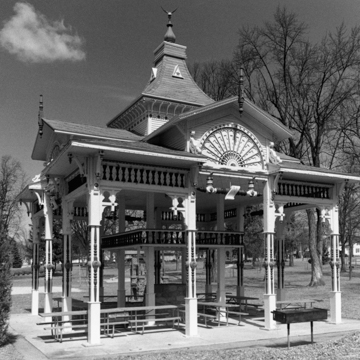During the late nineteenth century, wealthy Americans flocked to fashionable spas. “Taking the waters”—drinking from mineral springs or bathing in them—was supposed to improve one’s health, but vacationers also came to escape cities, relax, and participate in genteel social activities such as open-air concerts and formal balls. Wisconsin’s spas were never as prestigious as such leading resorts as New York’s Saratoga Springs, but they drew many health and pleasure seekers.
In 1880, homeopath George Swan opened Vita Park, using the Latin word for “life.” He claimed its spring water could relieve kidney, bladder, and urethra ailments. Working with a Chicago landscape architect, he turned a former cow pasture into an idyllic park, with a four-story hotel, croquet grounds, tennis courts, ponds for boating and bathing, and winding paths shaded by ivy arbors and thousands of trees. Guests could lounge on the hotel verandas or gaze at the grounds from the hotel observatories. There were also bathhouses, a greenhouse, “air castles” in trees reached by winding stairs, a band shell for concerts, and, of course, the spring itself, sheltered under an elegant canopy. Though Swan’s resort flourished in the early 1890s—it was especially popular with health seekers and those fleeing yellow fever in southern cities—it never proved profitable, and the hotel closed in 1893.
The only surviving structure is the Queen Anne pavilion that covered the spring (capped in 1905). The small pavilion is elaborated with such Eastlake decoration as spindle friezes beneath the eaves, spindle finials terminating the gables, brackets, and wooden sunbursts in the gable ends. The roof comprises a pyramidal base, cross gables, and a square belvedere, crowned by a bracketed mansard roof, which provides a perch for a cast-iron eagle. The city acquired the resort grounds in the early twentieth century and converted the property into a public park. George Swan’s Queen Anne–style house, which boasts a cone-roofed turret, stands nearby at the corner of Park and N. Vita avenues.


